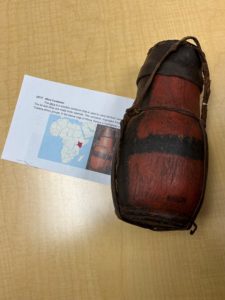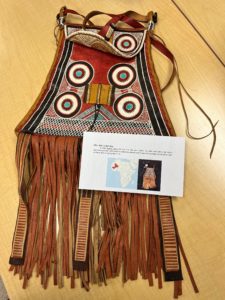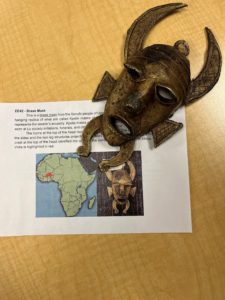by Patrick McShea
Teaching with African Artifacts at Pittsburgh Public Schools’ Gifted Center
At Pittsburgh Public Schools’ Gifted Center, Cheree Charmello Andrews has long used a set of handcrafted objects from the Educator Loan Collection of Carnegie Museum of Natural History to help her seventh and eighth grade students better understand the diverse Peoples of the African Continent. The K-8 school, which is in the city’s Elliot neighborhood, serves students throughout the school district whose Individual Education Plans (IEPs) identify them as gifted. Students visit the Center once a week to participate in innovative programs developed and presented by some two dozen faculty members.

The set of materials Cheree borrows can be broadly described as contemporary African Artifacts that reflect deep cultural history. Among the 18-item set are carved wooden figures, hammered aluminum utensils, ornate leather pouches, miniature masks in cast brass, a colorful hand-stitched story cloth, a canteen fashioned from a dried gourd, and even a fully functional set of dance bells, a musical instrument traditionally worn as ankle adornment. All the objects are sturdy enough for handling, and in-hand their educational power is enhanced when the name of the cultural group each represents is supplied – Senufo, Samburu, Turkana, Akamba, and Masai.

Preparing African Artifacts for the Educator Loan Collection
Some of the Masai and Samburu materials were purchased for educational use in the 1980s by a CMNH mammal curator performing fieldwork in Kenya. The acquisition history of the other objects is unknown, but the story of the small collection’s organization for education use is clear, and worth wider sharing. During the summer of 1992, then Cornell University sophomore Marcus McFerren was a work-study student in the CMNH Division of Education. When he expressed interest in preparing the African cultural objects in a storage cabinet for classroom use, the project became his principal work assignment. Marcus established personal connections with the librarians who then managed the African American Collection at the University of Pittsburgh’s Hillman Library, and with their assistance, created simple background information sheets for each object.

For the past 25 years, Marcus has been Dr. McFerren. He is a Board-Certified Dermatologist with a practice in Connecticut, who completed a PhD in Plant Biology at Cornell before he entered medical school. As a skilled ethnobotanist, he has conducted his own fieldwork at several locations in Africa. Six years ago, when Marcus visited the museum with his wife and two sons, he asked to see the educational materials he prepared so many years earlier. He’s due for an update because of recent upgrades.

2021 Updates and Current Use
In the fall of 2021 two small teams of Duquesne University students created new labels for the African objects as a volunteer project for a seminar class titled, Science at the Service of Society. Labels now pair object images with simple maps marking their county of origin. Perhaps of greater importance, Cheree recently shared the story behind her use of the well-worn authentic objects. It’s a brief account that nonetheless encompasses art, natural history, and most of all, what skilled teachers can accomplish:
Years ago, I designed a class called #BlackMindsMatter in response to a beloved Black student who expressed that she felt her culture was consistently left out of the academic setting in any positive or substantial way. I began to use the museum boxes in my classroom as a way of helping students access a beautiful legacy that is not always included in Eurocentric curriculum. As a white woman, it can be challenging to help students connect to the vast diaspora of Black culture. I paired the artistic genius of old and new African art and artifacts with modern Black art. We explored the parallels between the older forms of African art with the work of historical and contemporary art and concluded that many artists had to be influenced by Black art and artifacts. It was illuminating and uplifting.
Cheree Charmello Andrews
Patrick McShea works in the Education and Visitor Experience department of Carnegie Museum of Natural History. Museum employees blog about their unique experiences and knowledge gained from working at the museum.
Related Content
Rising Through the Educator Ranks
Expanding the Scope of Environmental Education
Carnegie Museum of Natural History Blog Citation Information
Blog author: McShea, PatrickPublication date: January 27, 2022
